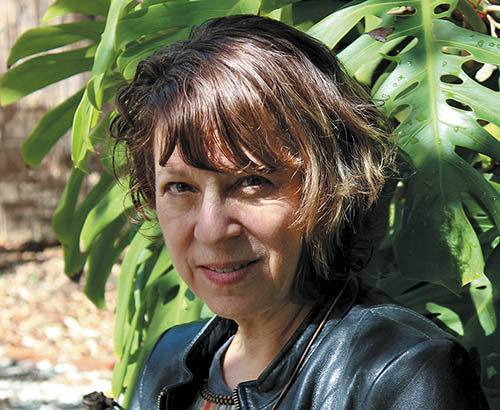
On May 2, at 7:30, Congregation Beth Sholom in Teaneck will present a lecture with video and slides about the painter and sculptor Eva Hesse, one of the most significant and least-understood Jewish artists of the 20th century. Hesse’s work is owned by numerous major museums around the world. Today, and for the next several months, her work is on view in New York in group exhibitions at MoMA, the new Met Breuer and the Drawing Center. Later this month, Yale University Press will publish a 900-page volume of her diaries. The speaker, Marcie Begleiter, is the director of a new full-length documentary, Eva Hesse, scheduled to have its world premier at the Film Forum in Manhattan on April 27 and run for two weeks. The trailer can be found at http://filmforum.org/film/eva-hesse-film.
Eva’s story begins in Hamburg, Germany in the 1930s when her father, a Jewish attorney, could no longer practice law under Nazi rule. Three weeks after Kristallnacht, in 1938, Wilhelm and Ruth Marcus Hesse put their two daughters—Eva, almost 3 years old, and her sister, Helen, age 5—on a kindertransport to Holland. Reunited a few months later, the family emigrated to New York and settled in Washington Heights where Eva attended Hebrew School and spent her summers away at Jewish camps. Her life was not without further tragedy as her mother committed suicide when Eva was 10, leaving her with a deep-seated fear of abandonment. From a young age, Eva wanted to be an artist and eventually used her mother’s German reparation money to pay for her art education at Yale University Art School. She then moved to New York City, the center of the 1960s art world, in an era dominated by male artists.
Marcie Begleiter, the evening’s speaker, spent the past five years doing research for her film, which explores Eva’s process of making art and the strong interrelationship between Eva’s life and her work. She provides interviews with many of the luminaries of the New York art world of the 1960s including leading artists like Sol Lewitt and independent art critics and museum curators and directors. Begleiter also includes interviews with Eva’s closest friends as well as several of today’s emerging artists who are seeing Eva’s painting and sculpture for the first time. There was unanimous agreement that Eva was an artist with seemingly unlimited creativity. She used new materials like latex, fiberglass, resin and rope and explored new biomorphic and geometric forms, with her work hanging from the ceiling, leaning against walls and rising up from the ground. Many of Eva’s works evoke strong emotions and reveal her absurdist sense of humor.
Eva’s career was meteoric, lasting only 10 years, at which point her life was tragically cut short at the age of 34 by a brain tumor. In the last year of her life, after the first of three brain surgeries and while suffering from excruciating headaches, she made some of her most important and innovative works. All who knew her concurred that she was intensely ambitious and despite all odds, determined to further the development of her art. Perhaps such courage and resilience, in the face of death, reflected the spiritual depth of her Jewish sensibility. In the words of Deuteronomy, when faced with life and death, she chose life so that the seeds of her art might bloom.
The program at Cong. Beth Sholom will include a 16-minute segment from the longer film along with photos and other images from the archive never seen before. There will be a Q and A after the formal program. This lecture is generously sponsored by the Alfred and Rose Buchman Endowment for the Fine Arts. It is free and open to the public with no reservations necessary. Light refreshments will be served.
Joan Boykoff Baron and Reuben M. Baron are co-chairs of this event. They are writers for artcritical.com, the online magazine of art and ideas.
By Joan Boykoff Baron and Reuben M. Baron










